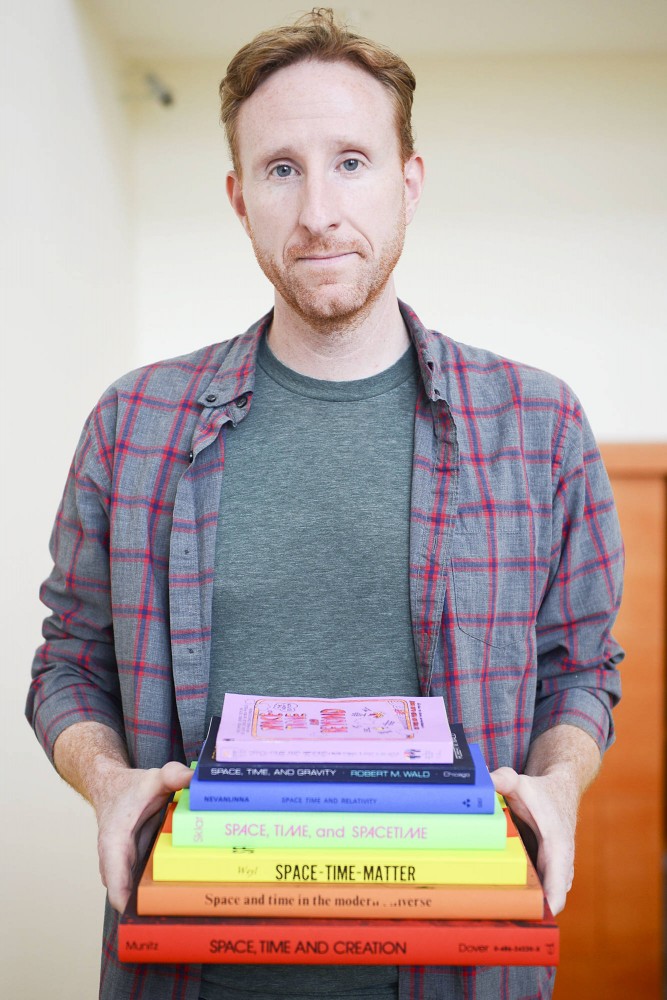Science can be dumb — or at least misinformed, according to photographer Eric William Carroll.
“The thing I love about humans doing science is that humans are inherently wrong,” he said.
A selection from a 1914 children’s encyclopedia explaining the future of space travel provides a great example in his latest exhibition at the Minneapolis Institute of Arts, “G.U.T. Feeling, Vol. 2.”
“It’s got these pictures of people flying through space on cruise ships with wings,” he said. “The book says that they hurtle through space at ‘the terrific speed of 120 miles per hour.’”
For Carroll, these moments give a sense of levity to a field that’s usually thought of as calculated and serious. “G.U.T. Feeling, Vol. 2” features photographs and sculptures depicting the artist’s fascination with the topic, including a portrait of Einstein made from 1,500 dice.
Carroll’s “G.U.T. Feeling” series aims to explore the idea of grand unification theories. The theory is a sort of holy grail for science that attempts to explain all laws of the universe in one elegant equation. Scientists have been searching for iterations of grand unified theory since the beginning of scientific inquiry, and Carroll’s exhibit seeks to explore the humanity within this search.
“There’s this underlying desire for understanding and organizing and explaining the world,” he said. “That’s the center of the interest for me. Whether or not you can speak that scientific language, you still have that desire.”
Most folks in the College of Liberal Arts would agree the language of science can be a mental tongue twister that makes complicated concepts difficult to understand. Carroll empathizes with this, so the photographs in “G.U.T. Feeling, Vol. 2” revolve around scale models that simplify science.
“I’ll sort of recreate these demonstrations through photographs,” he said. “We can’t really comprehend the size of the universe. I love it when science dumbs it down to a more human scale — how can a ping pong ball represent an entire galaxy?”
Essentially, Carroll said, “G.U.T. Feeling, Vol. 2” explores what we can understand about the cosmos without resorting to math.
This approach is different than the first volume of “G.U.T. Feeling,” which premiered in San Francisco last year. Carroll said that version of the exhibit was mainly focused on Einstein and his equations. The photographer wanted to capture the visual poetry of science rather than the human curiosity that fuels it.
“When I look at an equation, I don’t understand it at all. It’s literally Greek,” he said. “As an artist, I like the rhythm and the form of it, how it looks. It’s kind of like how you might see a musical score and find it interesting, even if you don’t read music. I tried to make images that spoke to the shapes that built up these equations.”
The first volume contained images that balanced the room they hung in. Carroll used three walls in the gallery to put up framed works that, when viewed as a whole, made the walls mathematically equivalent to one another, mirroring one of Einstein’s equations. These photos represented a multitude of scientific concepts and events, one of the most expansive being a grid of 20 pictures that included images of microscopic life, Carroll’s eyeball and some of the universe’s earliest nebulas.
While the second volume is just as fixated on symmetry and organization, its intentions are less concerned with equations. Carroll populated his new exhibit with images that vary greatly in size. Some photos are only an inch tall, whereas the largest piece is 8 feet by 11 feet. Carroll uses these differences in scale to play with the idea of particles in the universe. He marries this aesthetic with the humanity of science in one section by placing photos in order of height on a drawing board — there are images as sterile as geometric grids and as simple as a single flower.
“I want audiences to be moved by that space,” he said. “I want to hang pictures on the wall and allow room for some sort of transformation to happen.”
What: “G.U.T. Feeling, Vol. 2”
When: 10 a.m.–5 p.m. Tuesday–Sunday (open until 9 p.m. Thursdays, opens at 11 a.m. Sundays), July 18–Sept. 28
Where: Minneapolis Institute of Arts, 2400 S. Third Ave., Minneapolis
Cost: Free














